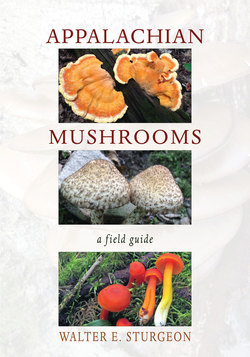Читать книгу Appalachian Mushrooms - Walter E. Sturgeon - Страница 19
ОглавлениеMEDIUM TO LARGE WHITE-SPORED TERRESTRIAL MUSHROOMS
Tricholoma and Melanoleuca
TRICHOLOMA IS A white-spored genus of generally medium to large mushrooms. Many species have a mealy odor. The gill attachment to the stem is typically notched. Many Tricholoma species fruit late in the season, often under conifers and after the first frosts. Identification of some of the gray and brown species is very difficult. The species included here can be identified relatively easily. One species of Melanoleuca is included here. Melanoleuca is a difficult genus to identify in the field. Many species are relatively uncommon. They typically have flat, umbonate caps with uplifted margins in age, and relatively long stems. Only one species is included here.
Melanoleuca alboflavida
Tricholoma intermedium
Tricholoma portentosum
Tricholoma virgatum
Key to Tricholoma and Melanoleuca
1. With a ring on the stem; cap white with brown fibers: Tricholoma caligatum (p. 89)
2. Ring absent; odor mealy; cap with yellowish-brown or reddish-brown scales or fibers: Tricholoma vaccinum (p. 94)
3. Ring absent; odor mealy; cap umbonate; cap yellowish to greenish yellow: Tricholoma davisiae (p. 95)
4. Ring absent; odor mealy or not distinctive; cap white, may have blue or yellowish stains: Tricholoma subresplendens (p. 91)
5. Ring absent; odor fragrant; cap not umbonate, with olive tints: Tricholoma saponaceum (p. 93)
6. Ring absent; odor unpleasant, like coal tar; gills white to cream; under conifers: Tricholoma inamoenum (p. 90)
7. Ring absent; odor unpleasant, like coal tar; gills yellow to yellowish buff; under broadleaf trees: Tricholoma odorum (p. 92)
8. Ring absent; odor fragrant; stem with black scabers: Melanoleuca verrucipes (p. 98)
SCIENTIFIC NAME: Tricholoma caligatum (Viv.) Ricken
SYNONYM: Armillaria caligata (Viv.) Gillet
COMMON NAME: None
FAMILY: Tricholomataceae
CAP: Up to 6 in. wide; white ground color, covered all over or at the center with brown, appressed fibers or scales; nearly round at first, becoming broadly convex to nearly flat; surface dry or tacky when wet; margin turned under and cottony at first, becoming expanded to uplifted, with veil remnants at times
FLESH: White to cream, unchanging when exposed; thick; odor mild; taste very bitter
GILLS: White, with brown stains in age, at times with bluish hues; attached, becoming notched; close to crowded; broad; edges even; at first covered by a thick membranous partial veil
STEM: Up to 4 in. long; white above the ring, brown scaled below, much like the cap; equal or tapering down; surface dry, covered from the base upward with a brown, scaled sheath that ends in a flaring ring, which is white above and brownish below
SPORE PRINT: White
ECOLOGY: Mycorrhizal with oaks and hemlock; scattered to gregarious in humus in broadleaf and mixed woods; late summer, fall, and early winter; locally common
EDIBILITY: Not edible owing to very bitter taste
COMMENTS: This is the common variety in the Appalachians. There are other varieties that have a fragrant odor and mild taste. These are generally considered edible. Future study may reveal new species in this group.
Tricholoma caligatum
SCIENTIFIC NAME: Tricholoma inamoenum (Fr.) Gillet
SYNONYM: None
COMMON NAME: None
FAMILY: Tricholomataceae
CAP: Up to 2 in. wide; whitish to pale buff; convex to broadly convex, becoming flat, at times with a low, broad umbo; surface smooth and bald
